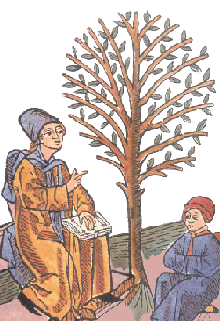The
Sanftlebens
Silesian Roots:
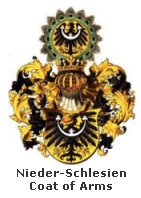 It
appears that most Sanftlebens can trace
their origins back to an area in central Europe commonly referred to as
Silesia or Schlesien. In fact, it appears that many of the
Schlesien Sanftlebens (sometimes recorded as Senftlebens) were
concentrated in Nieder, or Lower, Schlesien, with quite a few in an
area south of the city of Breslau around the town of Frankenstein. It
appears that most Sanftlebens can trace
their origins back to an area in central Europe commonly referred to as
Silesia or Schlesien. In fact, it appears that many of the
Schlesien Sanftlebens (sometimes recorded as Senftlebens) were
concentrated in Nieder, or Lower, Schlesien, with quite a few in an
area south of the city of Breslau around the town of Frankenstein.
Although Slavik peoples began to settle in Silesia under the feudal
sovereignty of Bohemian dukes as early as the 9th century, the region
did not come under the rule of a Polish King until the 10th
century. As the area was sparsely populated, the Bohemian
rulers actively recruited Germans to settle in the area, and by the
mid-1200s the region, to include its towns
and cities, was distinctly Germanic. In the mid-14th century,
Poland renounced all claim to the region, the King of Bohemia
assumed sovereignty, and Silesia became part of the Holy Roman Empire
and subsequently the Austrian Empire from 1526 until 1742 when it was
annexed by Prussia.
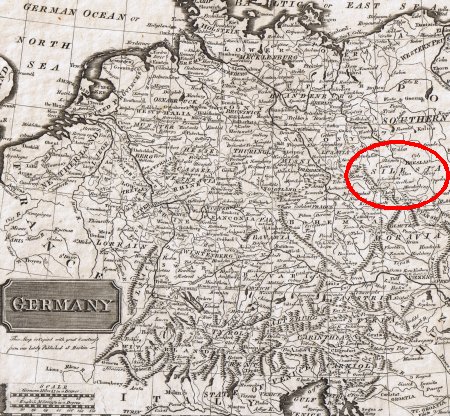
In the closing months of World War II, the Soviet Army began to
systematically drive the German inhabitants of Silesia from their
homes, forcing them to walk westward through the snow in temperatures
that approached -15 degrees Fahrenheit. Frequently the long,
slow-moving columns were strafed by Soviet aircraft, and records of
outright murder by Soviet ground forces exist. It has been
estimated that over 2 million Germans died from starvation, cold, and
Soviet bullets during this ethnic cleansing . Following the
war, Schlesien
was ceded
to Poland and renamed Slask; Breslau was renamed Wroclaw; and
Frankenstein was renamed Zabkowice Slaskie.
In many ways, the ravages of Silesia's ethnic cleansing during the 20th
century is reminiscent of the
horrors
inflicted on the region during
the Thirty Years War (1618-1648). During the early years of
the
Protestant Reformation in the 16th century, the majority of the
population of Bohemia and Silesia became Lutheran. In 1617,
Ferdinand, the Catholic Duke of Styria, became the King of Bohemia and
immediately ordered the Protestants of Prague to cease building
churches. The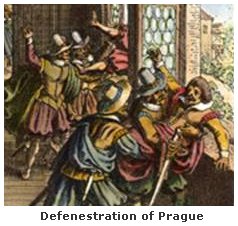 Protestant
princes
resisted as
they believed this act to be in violation of rights of religious
freedom
granted to them by the throne nearly ten years earlier. Two
of
Ferdinand's ministers who tried to enforce the edict were tried at an
assembly in Prague Castle, and when found guilty, physically thrown
through the highest windows of the Bohemian Chancellery.
Fortunately for the ministers, they survived the fall, but only because
they had landed in a giant manure pile. This "Defenestration
of
Prague" sparked the Thirty Years War. Protestant
princes
resisted as
they believed this act to be in violation of rights of religious
freedom
granted to them by the throne nearly ten years earlier. Two
of
Ferdinand's ministers who tried to enforce the edict were tried at an
assembly in Prague Castle, and when found guilty, physically thrown
through the highest windows of the Bohemian Chancellery.
Fortunately for the ministers, they survived the fall, but only because
they had landed in a giant manure pile. This "Defenestration
of
Prague" sparked the Thirty Years War.
In 1929, Heinrich Gabriel authored a book, Am Born der Heimat,
that included a
memoir of life in Silesia during the Thirty Years War, written by the
city clerk of Frankenstein, Kaspar Gloger. His father, a
master
baker, had served as a city-juror from 1635-1640 and a councilman from
1640 until his death in 1650.
Children, when I tell you my
experiences in
the Thirty Years
War, terrifying pictures appear in my soul.
Still
today after twelve years of the peace, I am
sometimes frightened
in my sleep if I dream of Saxon Landsknechts and Swedish cavalrymen.
In the first two years of the
war, I knew
little about it as
I was only six years old. Also,
those
of us living in Schlesien cared little about the  troubles
that the Emperor [Ferdinand II] had
begun in Bohemia. But
21 February 1620
is a date that I still remember well.
We
children followed a group of magnificent coaches
that had appeared at
the arboretum as it traveled to our castle. troubles
that the Emperor [Ferdinand II] had
begun in Bohemia. But
21 February 1620
is a date that I still remember well.
We
children followed a group of magnificent coaches
that had appeared at
the arboretum as it traveled to our castle.
In the third car sat the
newly selected King
of Bohemia,
Friedrich V, who was stopping for the evening on a trip to Breslau to
receive
homage. When I returned home late that evening, my father scolded me
and made
me stand alone in the room as a lesson because my curiosity at the
castle may
have led others to believe that I was celebrating the Bohemian
insurrection that followed the death of the Holy Roman Emperor,
Matthias, in 1619 and his succession by
Ferdinand II. (During
1617, Matthias
reversed a long-standing policy of state tolerance of the Protestants
and
attempted to forcefully reconvert them to the Catholic faith. After his
sudden
death, Ferdinand began to increase the pressure, and the mobility of
Bohemia
revolted.) Despite
my father’s sympathy
for the Protestant cause, he worried that the conflict would soon
spread to
Schlesien and devastate our homeland. His fears were correct for
following the defeat of
the Bohemians at the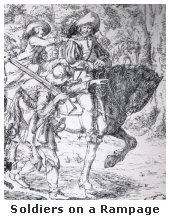 Battle of White Mountain (where their army of 25,000 was overwhelmed
by the
superior numbers of the Imperial forces)
Schlesien
overflowed with
deserters, wounded, and refugees.
Battle of White Mountain (where their army of 25,000 was overwhelmed
by the
superior numbers of the Imperial forces)
Schlesien
overflowed with
deserters, wounded, and refugees.
Still, we might have been
spared from the
conflict as most of
the Protestant Schlesichen nobility quickly withdrew its support for
Friedrich,
however in 1621, the Lutheran Duke Johann George von Jaegerndorf, led
his
forces from Brandenburg to confront the Imperial Army at fortified city
of
Glatz. Now,
the war came; the
Imperial
forces retreated from Glatz and burned the fields of Camenz and
Giersdorf as it
departed. Later in
August, the Imperial
Army returned and occupied Saxony and Schlesien as it laid siege to
Glatz.
Oh,
children, the soldiers were upon us! The scum of the earth. They cared nothing for our
region or
traditions. They
plundered our homes
and farms, and if we resisted we were
assaulted and
murdered. Our
choice was between misery or
grisly
death. The Imperial
army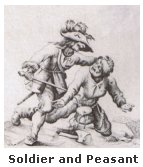 occupied our
homes for 42 weeks without ever attacking
the Protestant
forces at Glatz. Frankenstein
alone was
required to support
1500 soldiers. It
was worse for the
nearby villages of Kunzendorf, Baitzen, and Altman, which were
completely
burned for their Protestant support.
Finally,
on 3 June 1622, the Imperial forces brought
in two large
cannons, named the Wingless Dragon and the Black Sow to fire upon the
walls of
Glatz, however the city continued to resist until 25 October.
occupied our
homes for 42 weeks without ever attacking
the Protestant
forces at Glatz. Frankenstein
alone was
required to support
1500 soldiers. It
was worse for the
nearby villages of Kunzendorf, Baitzen, and Altman, which were
completely
burned for their Protestant support.
Finally,
on 3 June 1622, the Imperial forces brought
in two large
cannons, named the Wingless Dragon and the Black Sow to fire upon the
walls of
Glatz, however the city continued to resist until 25 October.
After
Glatz was retaken, the Imperial army gradually left the area, however
we now lived with poverty, hunger, and inflation.
Little
food was available in Frankenstein as all of our farms had
been destroyed. Work
and trade came to
a halt. Despite the
inability to earn a
living, we were required to pay the Empire one silver reichstaler and
15 to 20
ordinary talers each year. For
these
reasons, despite the peace, the city and surrounding farms could not
recover.
In August, the Empire
declared a new war
emergency, and the
Imperial army 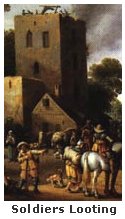 conscripted
one-tenth of all
Schlesien men to serve unwillingly
in its labor battalions. Protestent
forces returned to our region as did Wallenstein’s Imperial army. The demands on our food
supply were
exorbitant. We
requested that
Wallenstein by-pass our city, which he did but only after demanding we
supply
beer, wine, and bread for 15,000 men.
I
spent long days and nights with my father in his bakery, but that was
far
better than having the Wallensteiners here in Frankenstein. Then, despite his promise,
Wallenstein
garrisoned
an infantry regiment in our city the following January. For six months
it
stayed making unreasonably severe demands for food and money. We were forced to give
them all of the
latter, and could only suffer their brutality in silence. To avoid the misery, my
sister, Annemarie,
and our father moved from town to Reichenstein to stay with my Uncle
Ziegler. My
brother, Christoph, and I
stayed, for we knew how to avoid the soldiers. conscripted
one-tenth of all
Schlesien men to serve unwillingly
in its labor battalions. Protestent
forces returned to our region as did Wallenstein’s Imperial army. The demands on our food
supply were
exorbitant. We
requested that
Wallenstein by-pass our city, which he did but only after demanding we
supply
beer, wine, and bread for 15,000 men.
I
spent long days and nights with my father in his bakery, but that was
far
better than having the Wallensteiners here in Frankenstein. Then, despite his promise,
Wallenstein
garrisoned
an infantry regiment in our city the following January. For six months
it
stayed making unreasonably severe demands for food and money. We were forced to give
them all of the
latter, and could only suffer their brutality in silence. To avoid the misery, my
sister, Annemarie,
and our father moved from town to Reichenstein to stay with my Uncle
Ziegler. My
brother, Christoph, and I
stayed, for we knew how to avoid the soldiers.
Wallenstein and his army
finally left in
June, but before
we could catch our breath, as Schlesien was now entirely under Imperial
domination, regional Catholic forces arrived and garrisoned our area
for 26
weeks behaving nearly as badly as the Imperial troops.
On top of all of our troubles, the Empire
forbid us to hold Lutheran services as we had been doing in the city
for sixty
years, and beginning in 1629 we were forced to become Catholic.
 For the
next three years, there was peace in
Frankenstein, but in 1630, the
Swedish King Gustavus Adolfus deployed his forces to assist our
Protestant
princes. Within two
years, the Swedish
troops arrived in Schlesien and forced the Imperial Army to withdraw
from
Breslau. In their
retreat, they
temporarily
occupied Frankenstein. Upon
leaving on
3 June 1632, they outrageously started a fire at the northwest corner
of the
ring that almost destroyed the entire city.
Only
the parish church, the school, and ten houses
survived. We
survived too, but only with
our naked
lives. The Swedes
arrived in September,
and everyone once more became Lutheran, however in November the
Imperial army
returned in force and bombarded the city.
The
Swedish forces withdrew, and we were forced to
change our faith once
more. For the
next three years, there was peace in
Frankenstein, but in 1630, the
Swedish King Gustavus Adolfus deployed his forces to assist our
Protestant
princes. Within two
years, the Swedish
troops arrived in Schlesien and forced the Imperial Army to withdraw
from
Breslau. In their
retreat, they
temporarily
occupied Frankenstein. Upon
leaving on
3 June 1632, they outrageously started a fire at the northwest corner
of the
ring that almost destroyed the entire city.
Only
the parish church, the school, and ten houses
survived. We
survived too, but only with
our naked
lives. The Swedes
arrived in September,
and everyone once more became Lutheran, however in November the
Imperial army
returned in force and bombarded the city.
The
Swedish forces withdrew, and we were forced to
change our faith once
more.
Our city now was little more
than a heap of
debris, and it
again had to grant Wallenstein’s armies passage.
The
outlying villages were in even worse shape.
The Imperial army brought us another dark
guest too, “the black plague.” I
knew
from my grandfather that the plague had visited Frankenstein three
times in the
past; that was in 1521, 1568, and 1606. Now it
came again and took thousands in our
principality. Large
numbers began dying in
the city in August
1633, and it continued until January.
I
alone carried around 30 corpses to the cemetery.
My
dear mother, brother Christoph, and the good Annemarie died
rapidly one behind the other. The
Imperial army flooded the quiet city, plundering all that remained, and
destroying the villages of Quickendorf, Peterwitz, Kleutsch, and
Zuelzendorf by
fire. Those who
could, fled to the
forests to escape the atrocities.
For
one and a half years, the scourge of God was upon us, yet we bore it
all as
routine. Even the
Prager Partial Peace
of 30 May 1635, which included Schlesien and freed us from supporting
Imperial
troops, brought no joy.
and 1606. Now it
came again and took thousands in our
principality. Large
numbers began dying in
the city in August
1633, and it continued until January.
I
alone carried around 30 corpses to the cemetery.
My
dear mother, brother Christoph, and the good Annemarie died
rapidly one behind the other. The
Imperial army flooded the quiet city, plundering all that remained, and
destroying the villages of Quickendorf, Peterwitz, Kleutsch, and
Zuelzendorf by
fire. Those who
could, fled to the
forests to escape the atrocities.
For
one and a half years, the scourge of God was upon us, yet we bore it
all as
routine. Even the
Prager Partial Peace
of 30 May 1635, which included Schlesien and freed us from supporting
Imperial
troops, brought no joy.
The following three years
were calmer, and
much of the city
could have been rebuilt using timber from the surrounding forests, but
Frankenstein now had only about one-sixth of its pre-war population,
and their
desire to build was paralyzed by fear of renewed hostilities. My father, however, was
one of the few with
energy, resolution, and faith in God despite all of the past strokes of
fate
and he heartily began to rebuild his bakery.
Fighting,
however, resumed in
1639 and continued until the final conclusion of the war.
Our lot was with the Swedes,
oppressors
though they could
be, and they occupied our city three more times: 1639, 1642, and 1645. The whole time, the
Imperial army harassed
us and sucked our livelihood like leeches with tax collecting stations
and toll
roads. With the
back and forth of troop
movements, we hardly knew which armies we were forced to accommodate
in our
city; we found them all to be thieves, robbers, murderers, and
arsonists. The
soldiers, themselves, were
no longer
concerned with fighting and victory; they had become gangs of robbers
and
highwaymen, staying only where there were things to be stolen or
consumed.
I wish to also tell of the
last great battle
for possession
of our castle. By
1645 our life was so
hard
under the Imperial gang that occupied our city, that we actually wished
we were
part of Sweden. Then,
they finally came
on 1 October under the leadership of General Koenigsmark.
Despite our agreement with
the general and
our delivery of
bread and beverage for 8,000 soldiers, no house remained unplundered. The next day the Swedes
advanced to
Patschkau without occupying the castle.
However,
they returned on 27 October and fortified
the city with a
strong unit and several cannons. The
Swedish leader, Captain Kraegel, clearly intended to stay, as he
resurrected
Lutheran services in the city and established defenses in the castle. Approaches
to the castle were 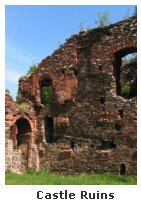 cleared
and
defensive barriers and trenches were
prepared. The city
was required to provide the Swedes
with
food, cattle, and
grain. cleared
and
defensive barriers and trenches were
prepared. The city
was required to provide the Swedes
with
food, cattle, and
grain.
The Imperial attacks were not
long in coming,
however they
were weak for the first six months, as the only damage inflicted was to
terrorize the citizens. Then
a large
Imperial army under the command of General Montecuccoli appeared
between the
end of June and 1 July of 1646 and attempted to force the Swedes out of
the
region. Since Kaegel could not hold the entire city against such
overpowering
odds, he and his soldiers withdrew to the castle to make a last stand. The Imperial army began
bombarding the
castle on 2 July with three heavy cannon placed on the Zadler Church
Bridge and
two mortars on Guergaes lane. Infantrymen
fired from trenches, barricades, and
windows, and repeatedly
assaulted the castle at night. The
Swedes courageously defended the castle for two weeks until mines were
emplaced
under the castle walls. They
surrendered on 13 July, and we became part of the Empire once more.
Count Montecuccoli then
ordered the castle to
be destroyed
so that the Protestants could never again use it as a fort. A sea of flame devastated
its insides and
left only the walls standing. The
powerful gate tower, however, resisted even a ton of powder.
We thought surely after this
destruction of
the castle that
the battles would now pass us by; however for the next two years,
Imperial
troops continued to move through our principality, extorting funds,
stealing
cattle and grain, and keeping us a shantytown.
Finally,
the war
ended with the Peace of Westphalia on 4
October 1648, but life improved only gradually, and we continued our
suffering
for many more years. Even today as I
write in 1660, the horrible wounds of the war still hurt. But
everywhere, new life is now beginning:
the farmer again plows his field; the businessman fills his warehouse,
and the
craftsman toils in his workshop. All
are anxious and hopeful.
Although
Herr Gloger
does not address it in his memoir, following the Peace of Westphalia,
Silesians were "strongly" encouraged to rejoin the Catholic faith, and
most did. Many of those families that did not, eventually
moved
to Protestant areas.
Whether or
not young
Christoffer Sanftleben lived in Frankenstein, this is the Silesian
climate he would have entered upon his birth in 1646. While
only
family records attest to his birth, and no records document his early
life, what is known is that Christoffer eventually became a cavalryman
in the Swedish Army.
To Christoffer
Sanftleben
|
